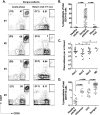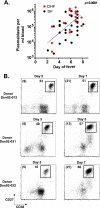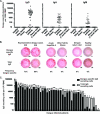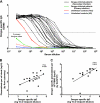Rapid and massive virus-specific plasmablast responses during acute dengue virus infection in humans
- PMID: 22238318
- PMCID: PMC3302324
- DOI: 10.1128/JVI.06075-11
Rapid and massive virus-specific plasmablast responses during acute dengue virus infection in humans
Abstract
Humoral immune responses are thought to play a major role in dengue virus-induced immunopathology; however, little is known about the plasmablasts producing these antibodies during an ongoing infection. Herein we present an analysis of plasmablast responses in patients with acute dengue virus infection. We found very potent plasmablast responses that often increased more than 1,000-fold over the baseline levels in healthy volunteers. In many patients, these responses made up as much 30% of the peripheral lymphocyte population. These responses were largely dengue virus specific and almost entirely made up of IgG-secreting cells, and plasmablasts reached very high numbers at a time after fever onset that generally coincided with the window where the most serious dengue virus-induced pathology is observed. The presence of these large, rapid, and virus-specific plasmablast responses raises the question as to whether these cells might have a role in dengue immunopathology during the ongoing infection. These findings clearly illustrate the need for a detailed understanding of the repertoire and specificity of the antibodies that these plasmablasts produce.
Figures




References
-
- Bernasconi NL, Traggiai E, Lanzavecchia A. 2002. Maintenance of serological memory by polyclonal activation of human memory B cells. Science 298:2199–2202 - PubMed
-
- Bethell DB, et al. 1998. Pathophysiologic and prognostic role of cytokines in dengue hemorrhagic fever. J. Infect. Dis. 177:778–782 - PubMed
-
- Bhamarapravati N, Tuchinda P, Boonyapaknavik V. 1967. Pathology of Thailand haemorrhagic fever: a study of 100 autopsy cases. Ann. Trop. Med. Parasitol. 61:500–510 - PubMed
Publication types
MeSH terms
Substances
Grants and funding
LinkOut - more resources
Full Text Sources
Other Literature Sources
Medical

